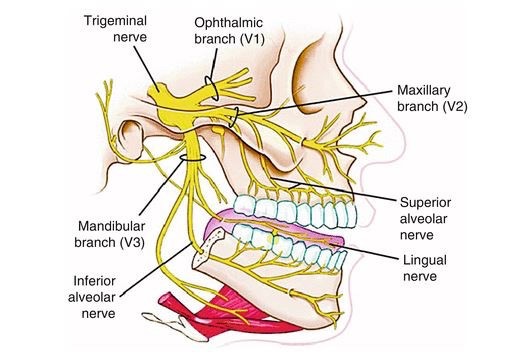
Did you know that there is a very large nerve that innervates much of the skull? It is called the trigeminal nerve and it looks kind of like this:
As you can readily see, this is one HUGE nerve and it covers a lot of surface area in your skull. It also just so happens that this nerve goes right through the temporomandibular joint (the TMJ). Now imagine if the articular discs in those joints are out of place and rubbing on the trigeminal nerve. Since this happens so often, the slipped discs that is, it would explain why so many people out there experience headaches on a regular basis. In my own practice, I see 4-5 new patients on an almost daily basis and 90% of them come in with headaches, which is unfortunate. The good news is that in 95% of those cases, the articular discs (the cartilage on top of the jaw bone) are out of place and are pinching nerves and blood vessels in that area. And since the trigeminal nerve is so omnipotent (that means it’s all over the place) it is likely being affected and this can cause all sorts of issues with headaches. Just like if you had a pinched nerve in your lower back due to a slipped disc, the jaw joint discs can cause the same problem which leads to pain. This is why when I begin to treat the situation, many of those headache and migraine symptoms slowly go away.
Almost every week I meet a new patient who has been to many different doctors over the years and when I tell them it looks like the discs might be out of place, they tend to be very skeptical. So I have to explain to them, don’t worry, you don’t have to believe me, but would you believe it if we did an MRI and had a board certified radiologist confirm the slipped discs are a problem? Most everyone believes this, however, over the years I have had a number of potential patients express that perhaps the radiologist just might be lying for me. Oh well.
So let’s get back to those slipped discs, shall we? When the discs slip out of place, they are then basically pinching the nerves and blood vessels in that area. Hopefully that makes a bit of sense. And, when I come along and make an appliance to take the pressure off that slipped disc, it tends to go back into position if it is able to and the patient feels better. It’s really that simple. Of course, in some cases that disc is just too damaged to go back where it belongs and surgery is indicated, but it does not happen often.
The message, dear readers, is that headaches and migraines are often due to a physical cause and once we identify that cause, treatment can be rendered. And the fact that 80-90% of the time this treatment works quite well, does indeed confirm that diagnosing the displaced discs is important to your course of treatment. So if you have head pain, like so many people do, please take the time to figure out what is going on.
